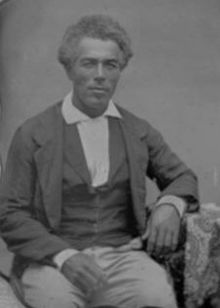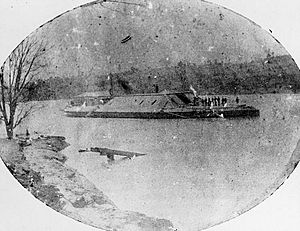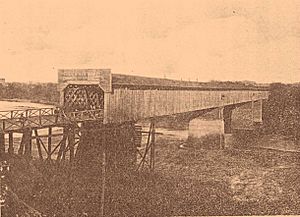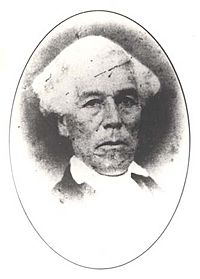Horace King (architect) facts for kids
Quick facts for kids
Horace King
|
|
|---|---|

Horace King during the mid-19th century
|
|
| Member of the Alabama House of Representatives | |
| In office 1868–1872 |
|
| Personal details | |
| Born | September 8, 1807 Chesterfield County, South Carolina, US |
| Died | May 28, 1885 (aged 77) Lagrange, Georgia, US |
| Political party | Republican |
| Occupation | Architect, Engineer, Contractor |
Horace King (sometimes called Horace Godwin) (September 8, 1807 – May 28, 1885) was an amazing African-American architect, engineer, and bridge builder. Many people consider King the most respected bridge builder of the 1800s in the Southern United States. He built many bridges in Alabama, Georgia, and Mississippi.
Horace King was born into slavery in 1807 in South Carolina. A slave trader sold him to John Godwin, who saw how talented Horace was. Godwin taught King to read, write, and build things, even though it was against the law to teach enslaved people at that time. King worked very hard. He built bridges, warehouses, homes, and churches. He became a highly skilled Master Builder. After the American Civil War, he even became a lawmaker in Alabama. People often called him Horace “The Bridge Builder” King or the "Prince of Bridge Builders." He also helped his community in many important ways.
Contents
Horace King's Early Life and Work
Horace King was born into slavery in 1807 in what is now Chesterfield County, South Carolina. His family background was a mix of African, European, and Catawba heritage. From a young age, he learned to read and write. By his teenage years, he was already a skilled carpenter and mechanic.
In 1824, Horace King likely saw his first bridge construction project. A famous bridge architect named Ithiel Town came to Cheraw, South Carolina, to help build a bridge over the Pee Dee River. Town's special "lattice truss" design, which uses a crisscross pattern, became a key part of King's own bridge building style later on.
Around 1830, King's first owner passed away. King was then sold to John Godwin, a contractor who had also worked on the Pee Dee bridge. In 1832, Godwin got a job to build a 560-foot (170-meter) bridge over the Chattahoochee River. This bridge connected Columbus, Georgia, to Girard, Alabama (now Phenix City). King moved with Godwin to Girard in 1833. They started many building projects together, including houses. The Columbus City Bridge was the first bridge King was known to have built. He probably planned its construction and managed the enslaved workers.
Becoming a Famous Builder
Between 1833 and the early 1840s, King and Godwin worked together on many big projects across the Southern United States. In 1834, they built about 40 cotton warehouses in Apalachicola, Florida. Some historians believe Godwin sent King to study at Oberlin College in Ohio. This college was the first in the U.S. to accept African-American students.
From 1839 to 1841, the two men designed and built courthouses for Muscogee County, Georgia, and Russell County, Alabama. They also built bridges in West Point, Georgia (1838), Eufaula, Alabama (1838–39), and Florence, Georgia (1840). In 1841, they built a new Columbus City Bridge because the first one was destroyed by a flood in 1838.
In 1837, during a tough financial time, Godwin transferred ownership of King to his wife and her uncle. This might have been done to protect King from being sold by Godwin's creditors. In 1839, King was allowed to marry Frances Gould Thomas, who was a free woman of color. This was very unusual for enslaved people. Because Frances was free, their children would also be born free.
By 1840, people publicly recognized King as a "co-builder" with Godwin. This was a rare honor for an enslaved person. By the early 1840s, King was even more famous than his owner. He started working on his own as an architect and supervisor for major bridge projects. These included bridges in Columbus, Mississippi (1843) and Wetumpka, Alabama (1844). While working on the Eufaula bridge, King met Tuscaloosa lawyer Robert Jemison, Jr. Jemison became King's friend and business partner for the rest of his life. King built a bridge over the Tallapoosa River at Tallassee, Alabama in 1845. Later that year, he built three smaller bridges for Jemison near Steens, Mississippi.
Gaining Freedom
Even though he was enslaved, King was allowed to keep a good amount of the money he earned from his work. In 1846, he used some of his earnings to buy his freedom from the Godwin family. However, a law in Alabama at that time said that a freed enslaved person could only stay in the state for one year after gaining freedom. Robert Jemison, who was a state senator, helped King. He arranged for the state legislature to pass a special law that gave King his freedom and allowed him to stay in Alabama. In 1852, King used his freedom to buy land near where his former owner lived. When John Godwin died in 1859, King had a monument built for his grave.
In 1849, the Alabama State Capitol building burned down. King was hired to build the main structure of the new capitol. He also designed and built the two spiral staircases at the entrance. King used his knowledge of bridge building to make the stairs look like they were floating, without any support in the middle.
Around 1855, King started a business with two other men. They built a bridge called Moore's Bridge over the Chattahoochee River near Whitesburg, Georgia. Instead of taking a payment for his work, King took a share of the bridge's ownership. He gained one-third interest in the bridge. Around 1858, King moved his wife and children to the area near the bridge. Frances King and their children collected the bridge tolls and farmed there. The money from Moore's Bridge gave King and his family a steady income. He also continued to design and build major bridges through the late 1850s. These included a large bridge in Milledgeville, Georgia, and another bridge over the Chattahoochee River in Columbus, Georgia.
During the Civil War
As the American Civil War began in 1860, King, like many Black people in the South, did not support the Southern states leaving the Union. After the war started, King tried to continue his building business. He built a factory and a mill in Georgia and a bridge in Columbus, Georgia. While working on the Columbus bridge, Confederate officials forced King to help build barriers in the Apalachicola River. These barriers were meant to stop a naval attack on Columbus. After finishing these, King was ordered to build defenses on the Alabama River before returning to Columbus in 1863.
By this time, Columbus had become a major place for building ships for the Confederacy. King and his workers were assigned to help build naval ships at the Columbus Iron Works and Navy Yard. In 1863–64, King built a rolling mill for the Iron Works, which made metal plates for Confederate ironclad warships. King's teams also provided wood for the Navy Yard. They were involved in building ships like the CSS Muscogee.
As the war neared its end in 1864, many of King's bridges were destroyed by Union troops. This included Moore's Bridge, which King owned. Union cavalry destroyed Moore's Bridge in July 1864. Frances King died on October 1, 1864, leaving King a widower with five children. In April 1865, Union general James H. Wilson attacked Columbus, burning all of King's bridges in that city. King remarried in June 1865 to Sarah Jane Jones McManus.
King and Reconstruction
The time after the war, known as Reconstruction, brought new chances for King. Within six months after the war ended, King and a business partner built a 32,000-square-foot (3,000-square-meter) cotton warehouse in Columbus. King also rebuilt the original Columbus City Bridge for the third time. Over the next three years, King built three more bridges over the Chattahoochee River. He also built two large factories and the Lee County, Alabama courthouse.
When new laws were put in place in 1867, King became a person who registered voters in Russell County, Alabama. Later that year, he tried to start a community for freed people in Georgia, but it didn't work out. In 1868, King was elected to the Alabama House of Representatives as a Republican for Russell County. He was busy with his construction business, so he didn't take his seat until November 1869. King was reelected in 1870. He didn't propose many new laws, but one of them, which stopped the sale of alcohol in Hurtsboro, Alabama, became law. King did not run for reelection in 1872.
Later Years and Legacy
King left the Alabama Legislature in 1872 and moved with his family to LaGrange, Georgia. In LaGrange, King kept building bridges. He also started building other projects, like businesses and schools. By the mid-1870s, King began to let his five children take over his bridge construction work. They formed the King Brothers Bridge Company.
King's health started to decline in the 1880s. He passed away on May 28, 1885, in LaGrange.
Newspapers in Georgia wrote very positive articles about King after he died. This was rare for African Americans in the South during the 1880s. He was later honored by being added to the Alabama Engineers Hall of Fame at the University of Alabama. He is remembered for his amazing engineering skills and his strong character.
Major Works by Horace King
- Columbus, Georgia Bridge (Destroyed by a flood in 1841). (1832–33)
- Forty cotton warehouses in Apalachicola, Florida. (1834)
- West Point, Georgia Bridge. (1838)
- Eufaula, Alabama Bridge (Taken down in 1924). (1838–39)
- Florence, Georgia Bridge. (1840)
- Replacement Columbus, Georgia Bridge. (1841)
- Muscogee County Courthouse. (1839–41)
- Russell County Courthouse. (1839–41)
- Red Oak Covered Bridge, Georgia. This bridge is on the National Register of Historic Places and is the last covered bridge designed by King that is still standing. (1840s)
- Second Columbus, Mississippi Bridge (Burned during the American Civil War). (1843)
- Wetumpka, Alabama Bridge. (1844)
- Tallassee, Alabama Bridge. (1845)
- Three smaller bridges near Steens, Mississippi. (1845)
- Inside structure and spiral staircases of the Alabama State Capitol in Montgomery, Alabama. This building is a National Historic Landmark. (1850–51)
- Moore's Bridge near Whitesburg, Georgia (Burned during the Civil War). (1855)
- Milledgeville, Georgia Bridge. (1850s)
- The Bridge House (Albany, Georgia) in Albany, Georgia. This building is on the National Register of Historic Places and is now used as the Albany Welcome Center. (1858)
- Third Columbus, Mississippi Bridge (Taken down in the 1900s). (1865)
- Tuscaloosa, Alabama Bridge over the Black Warrior River (destroyed by a tornado in 1880). (1872)
See also
- F.L. Cherry, "The History of Opelika and Her Agricultural Tributary Territory," The Alabama Historical Quarterly 15, No. 2 (1953), Chapter V.
- John S. Lupold and Thomas L. French, Bridging Deep South Rivers: The Life and Legend of Horace King (Athens, Georgia: University of Georgia Press, 2004), ISBN: 0-8203-2626-7.
- HORACE: The Bridge Builder King (Documentary), Produced by Tom C. Lenard. .






